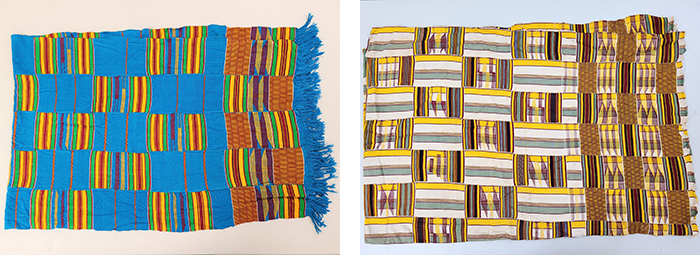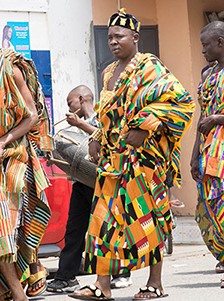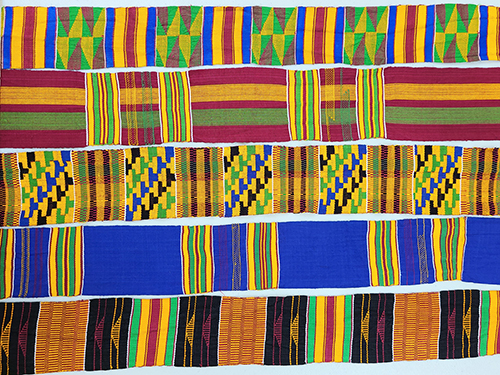Ghana: Weave a Kente Cloth
The invention of kente cloth is often attributed to the Ashanti people in Ghana. An Ashanti legend called The Spider Weaver tells how two young men were taught to weave kente cloth by a spider. You can listen to the story here. However, the origins of kente cloth are uncertain. Kente cloth production may have only begun 400 years ago in West Africa, or it may have roots in the textile production of the Akan people of the Ivory Coast and the Ewe people of southeastern Ghana from as early as 1000 BCE. Although its origins are debated, historically and in modern times kente cloth is associated with the Ashanti people.


Originally, kente was a sacred cloth that symbolized royalty and status because it was worn only by kings, queens, and members of the royal family of the Ashanti kingdom. Traditionally, the royal cloth was worn by men wrapped over their shoulders like a Roman toga while women wore it in two pieces, an ankle-length dress and a shawl that could double as a baby sling. Over time other people began to wear kente cloth for special, important, and festive occasions like weddings, births, graduations, and funerals.
Handwoven kente cloth is woven on a loom by men. The first step is to create long strips or bands of fabric around 6”-10” wide. Each of these bands is composed of bright colors and alternating designs. A larger sheet of kente cloth is assembled by hand sewing the long bands together.

Kente cloth is full of symbolism because of the geometric patterns and vivid colors. Here are some of the most popular colors and their meanings:
- Yellow = preciousness, fertility, and beauty
- Red = life, bloodshed, passion, and death
- Pink = female essence of life, and gentle aspect of red
- Purple = feminine aspects of life, usually worn by women
- Maroon = Mother Earth and healing
- Blue = peacefulness, love, and harmony
- Green = Mother Africa, vegetation, planting, harvesting, growth, and renewal
- White = purification, sanctification rituals, and festive occasions
- Grey = healing and cleansing rituals
- Black = people, unity, union with ancestors, and spiritual awareness/energy
- Silver = serenity, joy, and associated with the moon
- Gold = royalty, wealth, strength, fortune, status, and spiritual purity
In addition to the colors, individual weavers give names to the patterns they create. For example, Nkum me fie na nkosu me aboten, which means ”Don’t kill my house and then mourn for me in public,” or Owu nhye dam which means ”Death has no fixed date.”
Today, kente cloth is universal to all the tribes in Ghana. It is worn in the traditional ways (toga style or dresses) but it is also made into hats, bags, and home accessories. Kente cloth is considered a national treasure and a symbol of African heritage.
Let’s Make Paper Kente Cloth!
Remember kente cloth is full of meaning and symbols. Each cloth tells something about the weaver or the wearer. So have fun using colors and symbols that represent you.
You will need:
- Colored or white cardstock/scrapbook paper
- Patterned cardstock or scrapbook paper would make cool designs
- Construction paper isn’t as stiff, but it will work
- Markers or colored pencils
- Scissors
- Tape
- Glue stick
- Ruler
- Pencil
This video from Art for the Creative Soul will show you how to weave a simple paper kente cloth:
You can see another way to make paper kente cloth from the Florence County Museum here.
You can also learn more about the history of kente cloth here.
